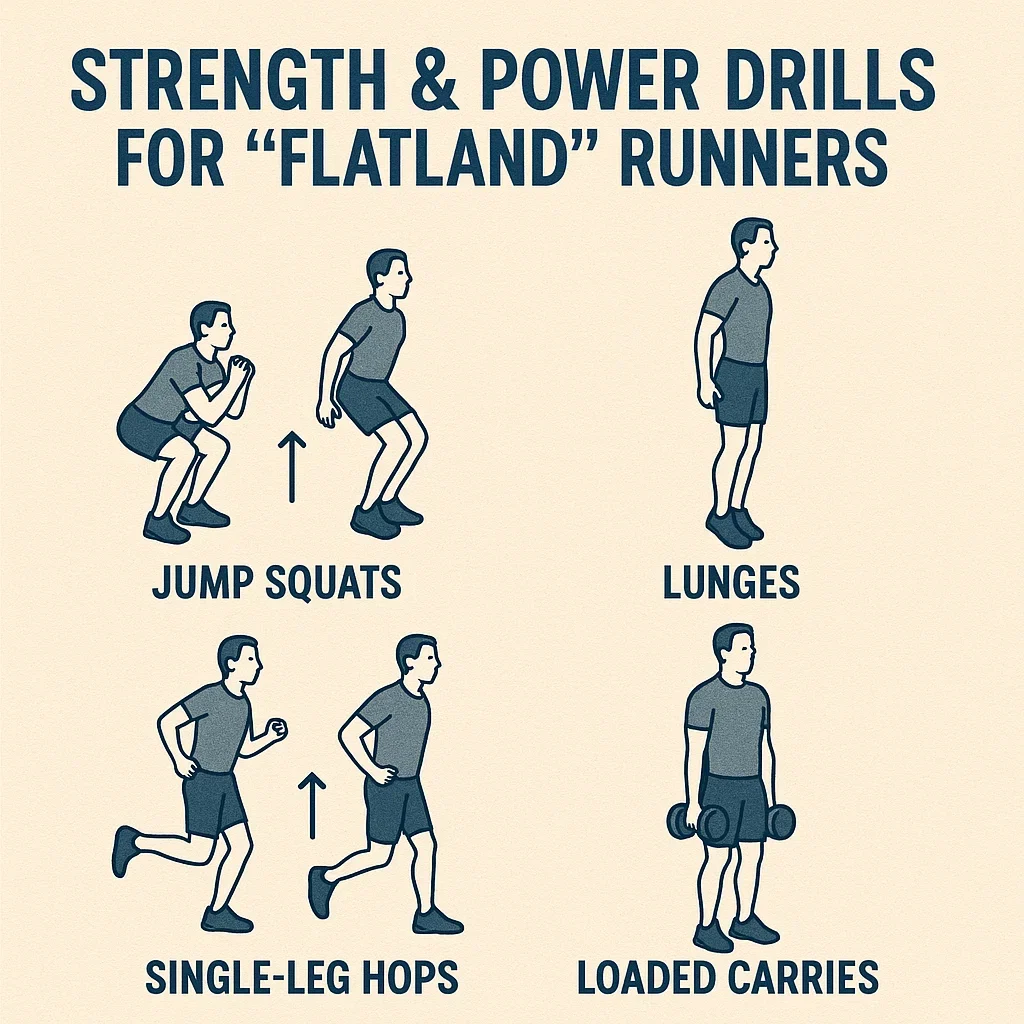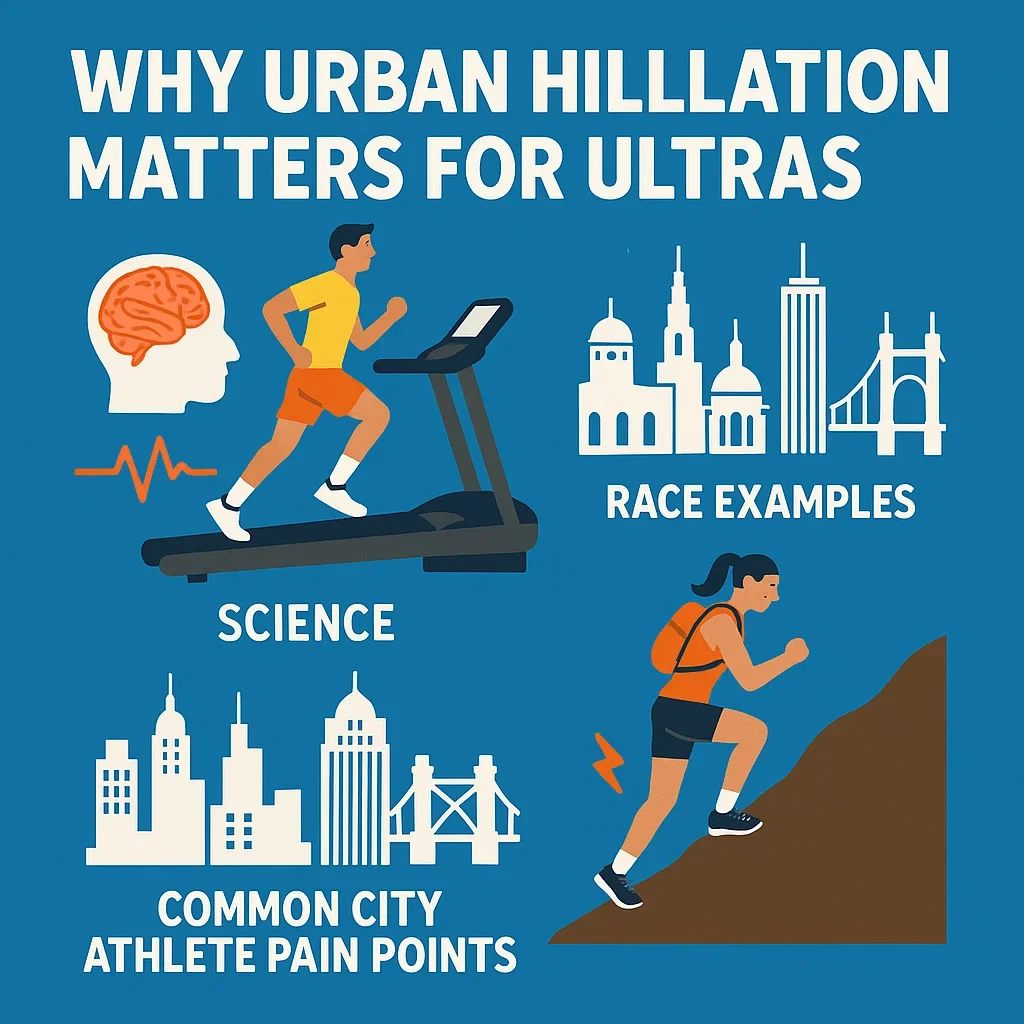No hills? No problem.
Training for an ultra in a flat city can feel impossible—but with creativity and the right tools, you can build mountain-ready strength and vertical endurance anywhere!
This guide unlocks city-tested ways to simulate trail climbs, boost your “vert,” and get a real ultra edge—even if your local routes are pancake-flat.
🏙️ Outdoor “Hill” Hacks: Where to Find (or Create) Elevation in the City
- Bridges & Overpasses: Most urban bridges offer gradual inclines—run repeats for steady climbing or stride work.
- Parking Garage Ramps: Long, winding ramps = hidden vert. Early morning or weekends are best for safety.
- Park Trails & Hidden Slopes: Even small local parks may have embankments or sled hills—repeat climbs add up!
- Stadiums & Sports Complexes: Bleacher stairs and stadium ramps deliver intense, time-efficient hill simulation.
- Multi-Location Circuits: Link 2–3 “urban hills” for a circuit run—max climbing, zero boredom.
- DIY Hills: Steep alleyways, playground mounds, construction site access (with permission), even sandbag carries up ramps.
🏢 Indoor Vert: Gym Machines Beyond Treadmill & Stair-Climber
- StepMill/Stepmaster: The “moving stairs” machine is the closest indoor equivalent to long hill climbs—continuous vertical, low impact.
- Incline Trainer: Treadmills with 10–40% incline—walk, hike, or run uphill, even at slow speeds, for massive climbing stimulus.
- Jacob’s Ladder: Self-powered ladder climber; full-body, functional vertical challenge (and a serious cardio test!).
- Plyometric Boxes: Step-ups, jump-ups, and loaded carries—great for “explosive vert” and power, especially when combined with traditional cardio.
- Weighted Vest Workouts: Add a vest (5–10% bodyweight) to stairs, treadmill hikes, or box step-ups for race-specific strength.
- Rowers & Ellipticals (on max incline): Not true climbing, but helpful for low-impact, high-output cross-training.
🔁 Sample Urban Hill Workouts: Beginner, Intermediate & Advanced
-
🔹 Beginner – City Hill Circuit
Find a short incline (bridge, ramp, park slope).
10 x (1–2 min up, easy walk down or flat jog). Focus on smooth effort, good form, and total time climbing. -
🔹 Intermediate – Multi-Location Hill Relay
Map 2–3 hill locations in your area.
Jog between sites; at each, do 3–5 climbs. Aim for 45–60 min total. Try to accumulate 150–300m vertical per session. -
🔹 Advanced – Urban “Everesting” Challenge
Pick one hill or parking ramp, set a vert target (e.g., 800m, 1000m, 1500m).
Do continuous repeats until goal is reached. Practice fueling and power hiking. Bonus: Try with a weighted vest!
💪 Strength & Power Drills for “Flatland” Runners
- Step-Ups (with or without weight): Use a sturdy bench, box, or stair. 3 x 12–16 reps/leg. Focus on full foot push-off.
- Walking Lunges: Forward, backward, or diagonal. 2–3 x 16–20 total steps. Great for hip and glute power.
- Single-Leg Calf Raises: Stand on a step; 3 x 12–15/leg. Builds calf strength for steeper climbs.
- Box Jumps or Jump Squats: 2–3 x 8–12 reps. Plyometrics = trail agility, downhill resilience.
- Loaded Carries: Hold a sandbag or backpack, walk up stairs, ramps, or flat for 1–2 min sets. Builds core + leg strength.
- Core Circuit: Planks, side planks, bridges—stabilize for better uphill power and injury prevention.
🧠 Mindset & Motivation: Training for Mountain Races Without Mountains
- Visualize Your Race: Picture yourself on race climbs, feeling strong—your mind can build “muscle memory” too.
- Focus on What You Control: Build vert wherever you can, hit your weekly goals, trust the process.
- Connect with Others: Share your journey online or with friends; find “city mountain” buddies for motivation and accountability.
- Gamify Progress: Set vert challenges, badge goals, or compete in virtual “climbing” contests.
- Celebrate Consistency: Every urban vert session gets you closer to your dream summit—recognize your efforts!
- Embrace the Advantage: City runners build mental toughness and discipline—skills that make you unstoppable on real mountains.
❓ Frequently Asked Questions: Urban Hill Simulation
🌉 How can I find “hills” in a flat city?
🏙️ Are treadmill inclines good enough for hill simulation?
🦵 What muscles benefit most from urban vert training?
⏱️ How often should I do hill simulation workouts?
🥤 How should I fuel for urban hill sessions?
💡 Can I train for mountain ultras entirely in the city?
👟 What shoes work best for urban vert training?
📲 How do I track my vertical gain?
🧰 Can gym circuits replace hill repeats?
🤔 What if I get bored doing the same hill over and over?

🔗 Further Reading
- How to Train for Mountain Ultras Without Mountains (CTS) – Smart vert hacks and power drills for city athletes.
- Urban Ultramarathon Training (iRunFar) – Creative city-based approaches to simulate tough trails.
🚦 Go Vertical—Even in the City!
Every bridge, ramp, and stair repeats brings you closer to your mountain goals. Stay creative, keep climbing, and show that big vert is possible—no mountains required!
- Find more urban ultra resources
- Share your favorite city “hill hack” on social media or with a friend
- Turn flatland into your own playground—get creative!

About the Author
Lost Pace is an ultramarathon runner, shoe-tester and the founder of umit.net. Based year-round in Türkiye’s rugged Kaçkar Mountains, he has logged 10,000 + km of technical trail running and completed multiple 50 K–100 K ultras.
Blending mountain grit with data, Lost analyses power (CP 300 W), HRV and nutrition to craft evidence-backed training plans. He has co-written 260 + long-form guides on footwear science, recovery and endurance nutrition, and is a regular beta-tester of AI-driven coaching tools.
When he isn’t chasing PRs or testing midsoles, you’ll find him sharing peer-reviewed research in plain English to help runners train smarter, stay healthier and finish stronger.
Ultrarunner · Data geek · Vegan athlete

